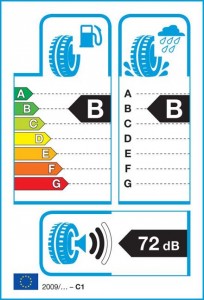
From 1 November 2012, EU labelling rules will dictate that all new tyres must show three key performance measures. The new regulations are likely to have a major effect on buying habits for company cars.
According to Stuart Jackson of the tyre industry safety organization TyreSafe, “This new legislation is one of the biggest changes to affect the way drivers buy tyres in recent years, but many motorists don’t even know it’s going to happen”. He’s probably right.
What are the changes?
The labelling will describe 3 performance indicators for all new tyres – braking distance in the wet, fuel economy, and external noise levels.
Wet braking performance – tyres’ wet braking will be rated from A – G, with A as the best. (The ratings will look like the EU energy efficiency information on white goods like fridges and washing machines.) A car on A-rated tyres will stop anything up to 18 m shorter than a car on G-rated tyres, according to the EU’s testing gurus.
Fuel efficiency – like wet braking, this is rated from A – G with A-rated tyres reducing fuel consumption by as much as 7.5% compared with G-rated ones.
Noise emission – this rates the amount of external noise the tyres emit. Unlike the other two, this is shown by the 3 little waves we all associate with speaker symbols on a PC. Three waves mean a tyre is noisy, one that it’s quiet.
Does it matter to you?
We rather think it does. We were impressed and surprised by the difference in wet braking and economy between the best and the worst rated tyres. 18 m is almost the length of a cricket pitch and therefore the difference between a serious tail end smash and a loud expletive from the driver. And for someone with business mileage of 10 000 miles a year in an average sort of car it’s a fuel saving of around £150 a year, not to be sneezed at if you’re running a few of them.
What’s missing? The gaping omission from a buyer’s point of view is tyre longevity, and that’s because the rules have been drawn up with safety and the environment in mind rather than your pocket. Otherwise the labelling provides some clear and objective differences between tyres which should please people who like purchasing decisions to be based on reason rather than just price or a brand name – the vast majority of good business car managers.







